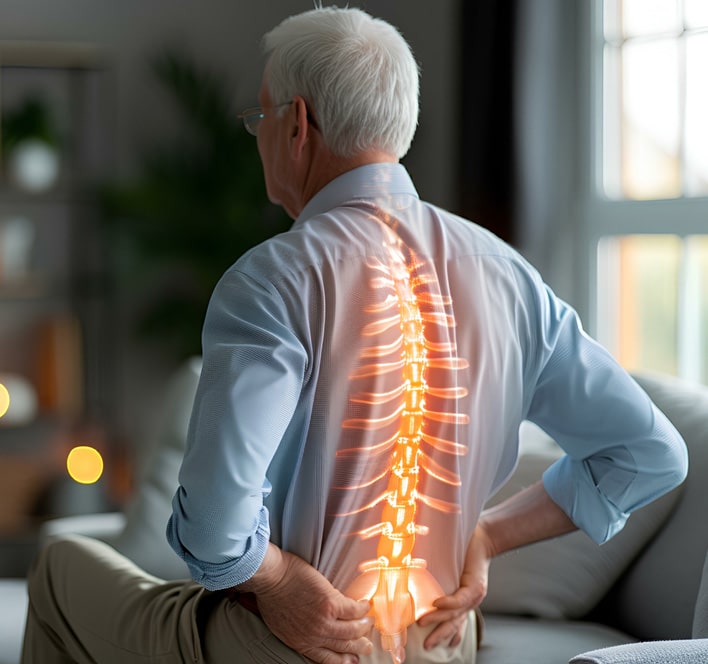Ankylosing spondylitis (AS) is a form of arthritis that primarily affects the spine. It causes inflammation and pain and can potentially lead to the fusion of vertebrae. This condition can significantly impact one’s quality of life, making it difficult to perform everyday activities. Understanding AS, its symptoms and available treatments is crucial for managing the condition effectively and maintaining a good quality of life.
At NJ Spine & Orthopedic, we diagnose and treat spine-related issues, including ankylosing spondylitis. Our team is dedicated to providing comprehensive care, from early diagnosis to advanced treatment options. Whether you’re experiencing mild symptoms or severe complications, we are here to help you navigate your journey with AS.
What Causes Ankylosing Spondylitis?
Ankylosing spondylitis (AS) is considered an autoimmune disorder in which the immune system mistakenly attacks the body’s own tissues. The exact cause of AS is not well understood, but genetic factors play a significant role. The presence of the HLA-B27 gene is strongly associated with AS, although not everyone with this gene will develop the condition. Environmental factors, such as infections, may also trigger or exacerbate AS in genetically predisposed individuals.
Inflammation is the hallmark of AS, primarily affecting the sacroiliac joints where the spine connects to the pelvis. Over time, this inflammation can spread to other parts of the spine and even to peripheral joints such as the shoulders, hips, and knees. In severe cases, chronic inflammation leads to the formation of new bone, causing sections of the spine to fuse in a fixed, immobile position.
Recognizing the Symptoms of Ankylosing Spondylitis
Early diagnosis of ankylosing spondylitis can be challenging due to its gradual onset and similar symptoms to other conditions. The most common early symptoms include persistent back pain and stiffness, particularly in the lower back and hips. These symptoms are usually worse in the morning or after periods of inactivity and tend to improve with exercise.
As the disease progresses, additional symptoms may develop, including:
- Pain and swelling in other joints, such as the shoulders, knees, and ankles.
- Reduced flexibility and range of motion in the spine.
- Chronic fatigue and a general feeling of malaise.
In some cases, ankylosing spondylitis can affect other parts of the body. Eye inflammation (uveitis) is a common extra-articular manifestation, leading to pain, redness, and sensitivity to light. Less commonly, AS can affect the heart and lungs, causing complications such as aortitis (inflammation of the aorta) or restricted chest expansion.
Diagnosing Ankylosing Spondylitis
Diagnosing ankylosing spondylitis involves a combination of clinical evaluation, imaging studies, and laboratory tests. During a clinical evaluation, a doctor will review your medical history, conduct a physical examination, and assess your symptoms. Imaging studies such as X-rays and MRI scans are essential for detecting characteristic changes in the sacroiliac joints and spine, such as inflammation, erosion, and new bone formation.
Laboratory tests can help support the diagnosis. While there is no specific blood test for AS, elevated levels of inflammatory markers such as C-reactive protein (CRP) and erythrocyte sedimentation rate (ESR) can indicate ongoing inflammation. Genetic testing for the HLA-B27 gene can also provide valuable information, although it is not definitive on its own.
Treatment Options for Ankylosing Spondylitis
Managing ankylosing spondylitis typically involves a combination of medication, physical therapy, and lifestyle modifications. The primary goals of treatment are to reduce inflammation, relieve pain, maintain spinal mobility, and prevent complications. Medications commonly used to treat AS include nonsteroidal anti-inflammatory drugs (NSAIDs) to reduce pain and inflammation, and disease-modifying antirheumatic drugs (DMARDs) or biologics for more severe cases.
Physical therapy plays a crucial role in managing AS. A tailored exercise program can help maintain flexibility, improve posture, and strengthen the muscles supporting the spine. Regular physical activity is essential for managing symptoms and improving overall health. In some cases, surgery may be necessary to correct severe spinal deformities or replace damaged joints.
How NJ Spine & Orthopedic Can Help
At NJ Spine & Orthopedic, we offer a comprehensive approach to managing ankylosing spondylitis. Our team is dedicated to providing personalized care that addresses your unique needs. We utilize the latest diagnostic tools and treatment techniques to provide the best possible outcomes for our patients. Whether you need conservative management or advanced surgical interventions, we are here to support you every step of the way.
Our concierge team is available to assist patients traveling from across the nation, coordinating accommodations and ensuring a smooth and comfortable experience. We understand the challenges of living with AS and are committed to helping you achieve the best quality of life through skilled care and innovative treatments. If you are struggling with symptoms of ankylosing spondylitis, don’t hesitate to reach out to us. Call NJ Spine & Orthopedic at (866) 553-0612 or visit our contact form to schedule a consultation. Our dedicated team is ready to help you take control of your health and improve your quality of life.

